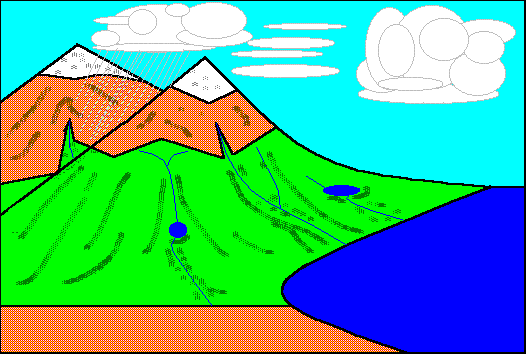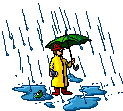|
|
 Rain Rain
How does rain form?
 Water droplets form from warm air. As the warm air rises
in the sky it cools. Water vapor (invisible water in the air) always exists in
our air. Warm air holds quite a bit of water. For example, in the summer it is
usually very humid. When enough of these droplets collect together, we see them
as clouds. If the clouds are big enough and have enough water droplets, the
droplets bang together and form even bigger drops. When the drops get heavy,
they fall because of gravity, and you see and feel rain. Water droplets form from warm air. As the warm air rises
in the sky it cools. Water vapor (invisible water in the air) always exists in
our air. Warm air holds quite a bit of water. For example, in the summer it is
usually very humid. When enough of these droplets collect together, we see them
as clouds. If the clouds are big enough and have enough water droplets, the
droplets bang together and form even bigger drops. When the drops get heavy,
they fall because of gravity, and you see and feel rain.
What causes rain?
 When clouds develop or rain occurs, something is making the air rise. Several things can make this
happen. Mountains, low-pressure areas, cold fronts, and even the jet stream.
When clouds develop or rain occurs, something is making the air rise. Several things can make this
happen. Mountains, low-pressure areas, cold fronts, and even the jet stream.
How big are raindrops?
  Raindrops are much smaller than we think! They are actually smaller than a centimeter. Raindrops
range from 1/100 inch (.0254 centimeter) to 1/4 inch (.635 centimeter) in diameter. Raindrops are much smaller than we think! They are actually smaller than a centimeter. Raindrops
range from 1/100 inch (.0254 centimeter) to 1/4 inch (.635 centimeter) in diameter.
How fast do raindrops fall?
 Not including wind-driven rain, raindrops fall between 7 and 18 miles per hour (3 and 8
meters per second) in still air. The range in speed depends on the the size of the raindrop. Air friction breaks up raindrops when they exceed 18 miles per
hour. Not including wind-driven rain, raindrops fall between 7 and 18 miles per hour (3 and 8
meters per second) in still air. The range in speed depends on the the size of the raindrop. Air friction breaks up raindrops when they exceed 18 miles per
hour.
|
|